17 Foods Rich in Folic Acid
Folic acid (folate, vitamin B9) is a water-soluble B vitamin. The richest food sources of folate are peas, spinach, liver and whole wheat products. In the last two decades, different foods items have been fortified with folic acid.
In the last two decades, different foods items have been fortified with folic acid. These include cereal, bread, cookies and even flour. (1)
Why is folic acid important for your health?
This vitamin is essential for the formation and proper function of new cells. It also helps prevent abnormal transformation of cells, which may contribute to reducing the risk of cancer. (2)
Folic acid deficiency can cause anemia. The folate deficiency anemia is common in females but may also affect men and children.
Folic acid is an essential nutrient for expectant mothers and for women planning to conceive. It helps prevent neural tube defects (NTDs).
Neural tube defects include severe brain and spinal malformation and agenesis. These defects occur early on in the pregnancy, even before many women are aware of their pregnancy.
This is the main reason why doctors recommend folic acid supplementation for women planning to conceive. Folic acid also helps reduce the risk of miscarriage. (3)
Recommended daily intake of folic acid is 400 micrograms (for males) and 400-600 micrograms (for females).
Experts recommend that women should start taking 400 micrograms of folic acid at least a month before they start trying to have a baby.(1)
Below we are going to talk about 17 foods that are rich in folic acid.
Asparagus
Asparagus are fleshy green spears full of various nutrient. For many people, the arrival of fresh asparagus in the farmer’s market marks the start of spring.
100g of asparagus contains about 149 mcg (microgram) of folate. This equals to 37% of the RDI. (4)
Asparagus is also a rich source of many vitamins, minerals, and dietary fibers.
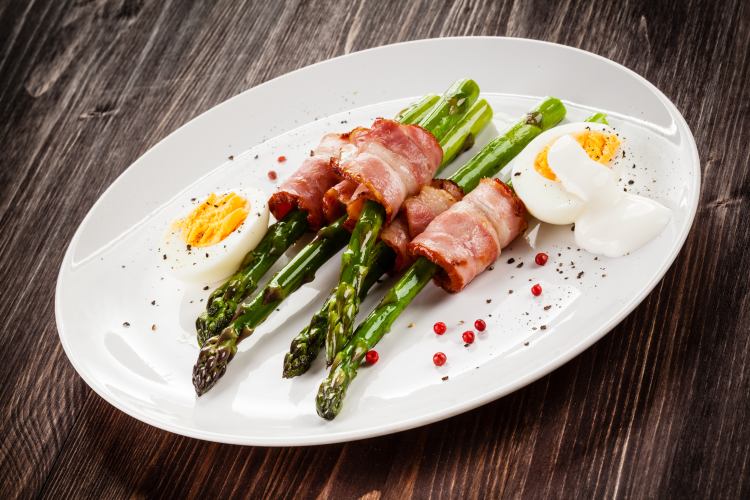
Asparagus, fried bacon and eggs
100g of asparagus contains 9% of RDI for selenium, 20 % of RDI for vitamin A and a whopping 63% of RDI for vitamin K.
It contains trace amounts of chromium that helps improve the ability of insulin to move glucose into the cells from the bloodstream. (5)
Eating asparagus helps prevent and fight certain types of cancer like breast and colon. Saponins present in asparagus stems have shown an inhibitory effect on certain cancerous tumors (6).
Asparagus is one of the top ranking vegetables for their antioxidant properties. Eating asparagus helps neutralize the free radicals that cause cell damage. Asparagus in turn also helps slow down the aging process.
There are no serious side effects associated with the intake of asparagus. Since it is rich in fiber, eating too much of it could lead to stomach upset, cramping, and gas.
How to add more asparagus to your diet?
Roasted asparagus is an easy and delicious way to add it to your diet. It makes an excellent side dish with almost anything and only takes a minimum effort to prepare.
Here is how you can make it:
Take a non-stick baking sheet and spared your asparagus on it.
Now sprinkle some black pepper, a little salt, and olive oil.
Bake this in the oven at 450°F (230°C) for 8 to 12 minutes.
Turkey liver
Turkey is meat that is loved by many but most people through away the turkey liver as a waste. Did you know that turkey liver contains the most concentrated amount of nutrients in the whole turkey?
Turkey liver is a rich source of folate and numerous other micronutrients. 100g of turkey liver contains more than the daily requirement of folic acid.
100g of turkey liver contains 691 mcg of folate that means 173% of RDI. (7)
Apart from folate, turkey liver is also super rich in many other vital nutrients.
Folate, iron and vitamin B12 in turkey liver help make new red blood cells. Eating liver is recommended to patients with iron deficiency anemia.
Copper present in turkey liver helps to keep our body functioning properly as it is a co-enzyme for many vital functions taking place in our body.
Copper helps produce energy, synthesize collagen, metabolize iron and to keep the nerves in our body healthy (8).
How to add turkey liver to your diet?
Sautéing turkey liver is easy and straightforward.
Here is how you can do it:
First, add a little butter to a pan.
Now to this pan add onions, garlic, and ginger.
Brown the onions and add the turkey liver. Season this with a little salt and pepper.
Your turkey liver is ready to eat.
Sunflower seeds
Sunflower seeds make a great snack for a long ride or a day at the park. They not only help ward off hunger but also add an abundance of nutrients to your diet.
100g of sunflower seeds contain 63.6 mcg of folate that means 16 % of the RDI (10).
Along with folate sunflower seeds are also packed full of other nutrients such as including vitamin E, thiamin, B6, copper and selenium. (10)
Vitamin E, folate and other nutrients present in sunflower seeds help promote cardiovascular and thyroid health.
Folate helps metabolizes homocysteine (that is an indicator of cardiovascular problems) into methionine (an essential amino acid). (11)
Weight gain is one of the main drawbacks of eating too much sunflower seeds. So it’s best to stick to 1-ounce serving.
A simple way to incorporate sunflower seeds into your diet is to add them to a trail mix.
Broccoli
Broccoli is a vegetable that is packed full of various nutrients.
The media have given it a nasty reputation and most children reject it without even tasting. Broccoli is not only good for your health but also good for your palate with its authentic taste.
100g of broccoli contains 63 mcg of folate. This equals to 16 % of the RDI for folate (11).
In addition to folate, broccoli also contains many other vitamins and minerals, which make it one of the healthiest vegetables in the market (11).
Eating too much of broccoli may lead to the buildup of gas or stomach cramps.
How to add broccoli to your diet?
If you boil broccoli, it will cause up to 90% of the nutrients to leach out.
Roasted broccoli is not only easy to make but is also yummy to eat. Here is how you can do it.
Take broccoli and place in on a nonstick metal sheet.
Drizzle some cooking oil on the broccoli and sprinkle some shredded cheese on top.
Add salt to taste and put in the oven at 450°F (230°C) for 15 minutes.
Avocado
Avocado is a fruit rich in flavor and nutrients. It has a creamy and smooth texture. It is referred to as fatty fruit because of its comparatively high-fat content.
The fat in avocado is mono-saturated.
Its rich nutritional profile makes avocado satisfying to eat.
Avocado is rich in many vitamins, dietary fibers, and minerals (12).
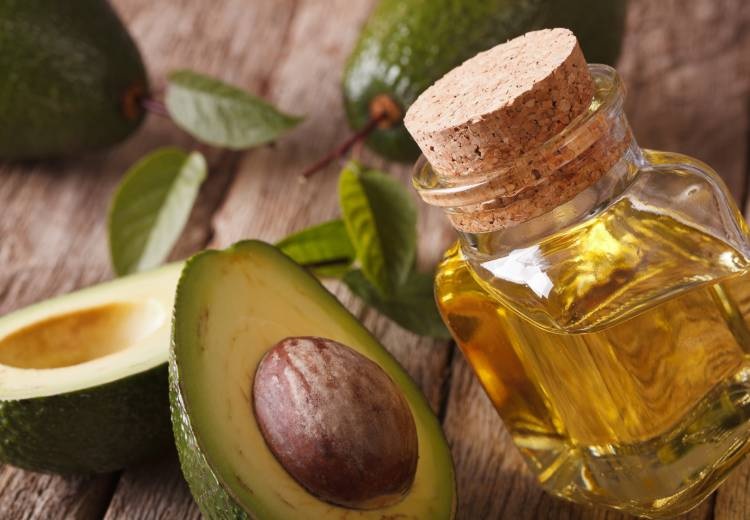
Avocado is high in folic acid
A 100g serving of avocado gives you 81 mcg of folate. This means that 100g of avocado provides 20 % of the RDI of folate (13).
Avocado is also a rich source of vitamin C, potassium and dietary fibers.
Studies have shown that eating avocado helps lower the risk of metabolic syndrome, which includes obesity, diabetes and cardiovascular conditions. (14)
Different studies have concluded that Hass avocado (most common type of avocado) could help in healthy aging and weight control. (15)
The Ohio State University found that adding avocado or avocado oil to salads can increase the absorption of carotenoids from other vegetables. The study showed up to 400% increase in absorption of carotenoids. (16)
How to add avocado to your diet?
Avocados can be eaten as such or in the form of guacamole. To make guacamole, you will need ripe avocado, salt, lemon juice, black pepper and onions.
Mash avocados in a large bowl and add finely chopped onions.
Add salt and black pepper.
Sprinkle a little lemon juice and mix.
Your guacamole is ready to be enjoyed with anything you desire.
Peanuts
Peanuts are one of the most commonly consumed nuts.
They are are rich in micronutrients, macronutrients, and phytochemicals. (17)
Peanuts in moderation are a part of weight loss diet plans. Due to their palatability and nutrition profile, they help satisfy hunger.
But eating too many peanuts can lead to weight gain as 100 g of peanuts contain 76% of the RDI for fat and about 585 calories. (18)
100 g of peanuts contain about 145 mcg of folate, which translates to about 36 % of the RDI for folate.
Adding peanuts to a salad is a great and easy way to get your RDI of folate from a single bowl.
Peanuts are rich in proteins, dietary fiber and minerals. They also contain vitamin E (35% of RDI),niacin (68% of RDI) and thiamin (29% of RDI).
Other minerals in peanuts include magnesium, phosphorus and manganese.
A proper diet including peanuts can provide all these vital nutrients and help promote health and prevent disease. (19)
Bananas
Bananas are one of the most commonly consumed fruits in the world.
What is more, they are not only delicious but also nutritious.
They make a great low-calorie snack and are great for digestion, heart contraction, and weight loss.
One large (118g) banana contains about 23.6 mcg of folate, which translates to 6 % of the RDI for folate (20).
Other vitamins found in bananas are vitamin C and vitamin B6.
They are also rich in pectin and resistant starch, which help moderate blood sugar levels and reduce appetite by slowing down gastric emptying. (21)
Studies show that eating bananas 4 to 6 times a week reduces the risk of kidney disease by almost 50 %. (22, 23)
Bananas are also high in magnesium, which makes them a heart-friendly food and contain powerful antioxidants called catechins, which have been linked to decreasing the risk of heart and degenerative disease. (24)
Tomato juice
Tomato juice is a powerhouse of nutrients. It is full of minerals, vitamins, and phytonutrients. Not only it promotes health but also helps prevent many diseases.
One cup (243 ml) of tomato juice contains 12 % (48.6 mcg) of the RDI for folate, helping the body make new red blood cells (25).
It also helps maintain the proper functioning of the existing cells.
In addition to folic acid, tomato juice is also an abundant source of antioxidants (mainly lycopene), which may prevent various diseases including certain types of cancers.
According to research at Tufts and Boston University, people who eat most lycopene have almost a 30% lower risk to get a coronary heart disease. (26)
Tomato juice is also relatively low in calories and has no fat in it, which makes it a great addition to your weight loss diet.
Other nutrients found in tomato juice include vitamin C (74% of RDI), vitamin A (24% of RDI), potassium (27% of the RDI), sodium (16% of the RDI) and iron (6% of the RDI). All these minerals, phytonutrients and vitamins may protect vision and lower the risk of degenerative eye diseases.
Oranges
Juicy and tangy oranges make a delicious snack and also add an extra layer of flavor to many recipes. Oranges are one of the most popular fruits in the world. They are packed full of vitamins, minerals, and phytonutrients.
Vitamin C is not the only reason to add oranges to your diet.
One medium orange contains 39 mcg (10% of the RDI) of folic acid (27).
And one cup (243 ml) of fresh orange juice contains 19 % of the RDI for folate (28).
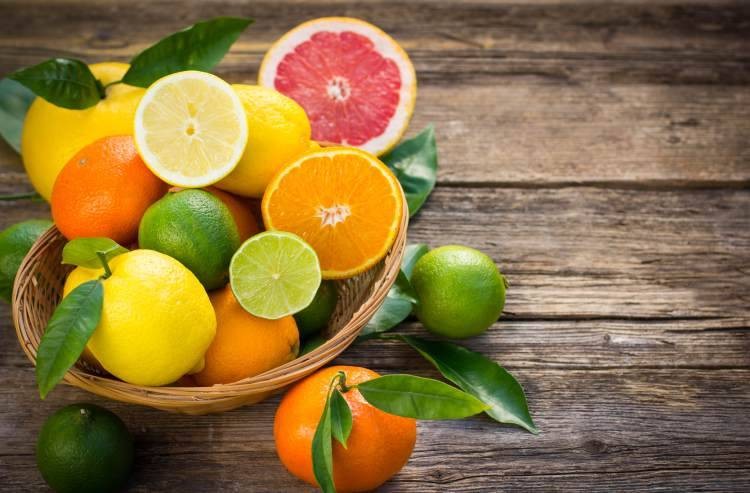
Citrus fruits and oranges are high in folic acid
Giuseppe Grosso and Fabio Galvano published a paper online in May of 2013 that illustrates the health benefits red oranges.
The research showed that red oranges have potent antioxidant activity and cytoprotective effect.
Thus they play a substantial role in preventing chronic pathological conditions like heart diseases and a certain type of cancers. (29)
One large orange is also high in potassium (10% of RDI) and calcium (7% of RDI).
Vitamin C helps boost the immune system and eliminate the free radicals in the body.
How to add oranges to your diet?
The best way is to eat organically grown oranges.
Make sure you wash the peel before consuming oranges or other citrus fruits. They are chemically treated and it is necessary to rinse them before eating. Also always remove the peel before consumption.
Do not drink excessive amounts of orange juice. It may actually do more harm than good.
Peppermint
Peppermint is a herb people have used for centuries for both culinary and therapeutic applications. Peppermint has a cooling sensation, a menthol aroma, and refreshing taste. It also has antioxidant and antibacterial activities and is full of vitamins and minerals.
One ounce (28g) of peppermint contains 31.9 mcg of folate or 8% of the RDI.
It also contains a fair amount of calcium, iron, manganese, vitamin C and vitamin A.
Peppermint mixed with water makes an excellent mouthwash, which kills most of the bacteria thanks to the antibacterial action of peppermint.
A study in 2013 concluded that peppermint is an effective treatment for infantile colic. The study stated that peppermint was almost as effective as a chemical simethicone for managing infantile colic. (30)
Peppermint is good for digestion. Peppermint oil helps in managing irritable bowel syndrome (31).
Studies have shown that peppermint extract has an inhibiting action on the release of histamine and helps alleviate the symptoms of allergic rhinitis (hay fever). (32)
Papayas
Papaya is a tropical fruit. In the past, they were only available in certain parts of the world. But nowadays you may buy them almost everywhere and around the year.
Papayas have bright orange flesh and delicious sweet taste and contain hundreds of gelatinous black seeds enclosed in their center.
One cup (140g) of papaya cubes contains 57.8 mcg of folate (14% of the RDI). (33)
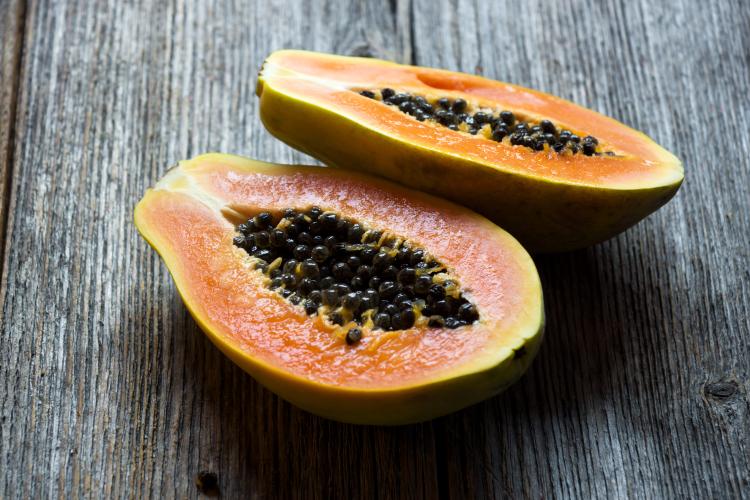
Papayas are fairly rich in vitamin B9
Papayas are also rich in vitamins, minerals, and other micronutrients, including dietary fiber, antioxidants, potassium (11% of the RDI), vitamin A (33% of the RDI) and vitamin C (157% of the RDI) .
In addition, papayas are very low in calories and fat.
So it’s a great addition to your diet and a fat-free way to fill up on many vital nutrients.
Beets
In the past, people used beets mainly in salads.
But recently people have become an essential part of a healthy diet.
They contain some unique phytonutrients, called betalains. Betanin and vulgaxanthin (two best-studied beet betalains) both have antioxidant and anti-inflammatory properties.
100g of beets provides 109 mcg (27% of the RDI) of folate, which helps lower blood levels of homocysteine. and reduce the risk of a heart disease (34).
In addition to folate and betalains, beets are also an excellent source of manganese (16% of the RDI) and vitamin C (8% of the RDI). On the other hand, they are virtually fat-free and low in calories.
Beets in salads or roasted beets are an easy way to incorporate these vegetables into your diet.
Brussels sprouts
Brussels sprouts are full of health-promoting nutrients and contain almost no fat.
Oven-roasted Brussels sprouts sustain all their nutritional goodness while diminishing its sulfurous odor and taste.
One ounce (28g) of Brussels sprouts contains 4 % (16.4 mcg) of the RDI for folate (35).
It is also rich in iron (2% of the RDI), phosphorus (2% of the RDI) and potassium (3% of the RDI).
They are also high in vitamin C (29% of the RDI) and vitamin K (49% of the RDI).
Brussels sprouts reduce the risk of bone fractures and certain cancers.
They also play a protective role against the UV light damage to the eyes. (36)
Squash
Squash is a delicious vegetable and many people think that it is just a winter food. But different types of squash are available all year around.
Squash is rich in vitamins, minerals, and phytonutrients.
One cup of squash contains 10 % (38.9 mcg) of the RDI for folate (37).
Squash is also rich in vitamin A (457% of the RDI), niacin (10% of the RDI), thiamin (10% of the RDI), vitamin E (13% of the RDI), vitamin B6 (13% of the RDI) and vitamin C (52% of the RDI), which make it a great food for prevention of eye disorders, such as cataracts.
Squash is also rich in minerals, mainly in copper, iron and manganese, which promote the production of red blood cells.
Iron and folate help with the production of red blood cells.
Melons (cantaloupe)
Melons are a popular juicy fruit. They have vibrant colors and sweet aroma.
Melons are full of essential vitamins and minerals.
One cup (177g) of this fruit contains no fat and only 60 calories.
There is also 9 % (37.2 mcg) of the RDI for folate (38).
Melons are also high in vitamin K, niacin, vitamin B6, vitamin C and vitamin A.
Other nutrients in melons include flavonoids (beta-carotene, lutein, zeaxanthin, and cryptoxanthin), which have high antioxidant properties and help reduce the risk of certain types of cancer like breast and lung. (39)
Kidney beans
Kidney beans are a rich source of vitamins, minerals, proteins and fiber.
One cup of kidney beans (177g) contains 109 mcg of folate, which translates to 27% of the RDI. (40)
Folate helps reduce the risk of heart and vascular disease.
Other nutrients found in kidney beans include fibers (alpha-galactosides), vitamin C, riboflavin, thiamine and minerals, such as iron, copper, potassium and zinc.
How to add kidney beans to your diet?
Kidney bean salad is the easiest and simplest way to add kidney beans to your diet.
Boil kidney beans and place them in a large bowl. Now add salt, black pepper, lemon, tamarind and any vegetables you like.
Mix to get an excellent kidney bean salad.
Spinach
Leafy dark greens like spinach are great for bone health, skin and hair. Spinach contains many vital micronutrients and macronutrients.
100 g of spinach provides almost half of the RDI for folate.
There is 194 mcg of folic acid in 100 g of spinach, which translates to 49% of the RDI (41).
Spinach promotes red blood cell production thanks to high folate and iron content.
Spinach is also a natural source of antioxidants and helps reduce the oxidative stress on the body. (42)
It also contains 604% of the RDI for vitamin K, which is an essential vitamin for bone health and blood coagulation. (41)
Other nutrients found in spinach include potassium and vitamin A.
How to add spinach to your diet?
There are many ways to add spinach to your diet. You can add spinach to salad, pasta or you can just sauté it.
Thing to remember
Folate is an essential nutrient for the body.
It plays a vital role in production and function of various cells in the body, including red blood cells.
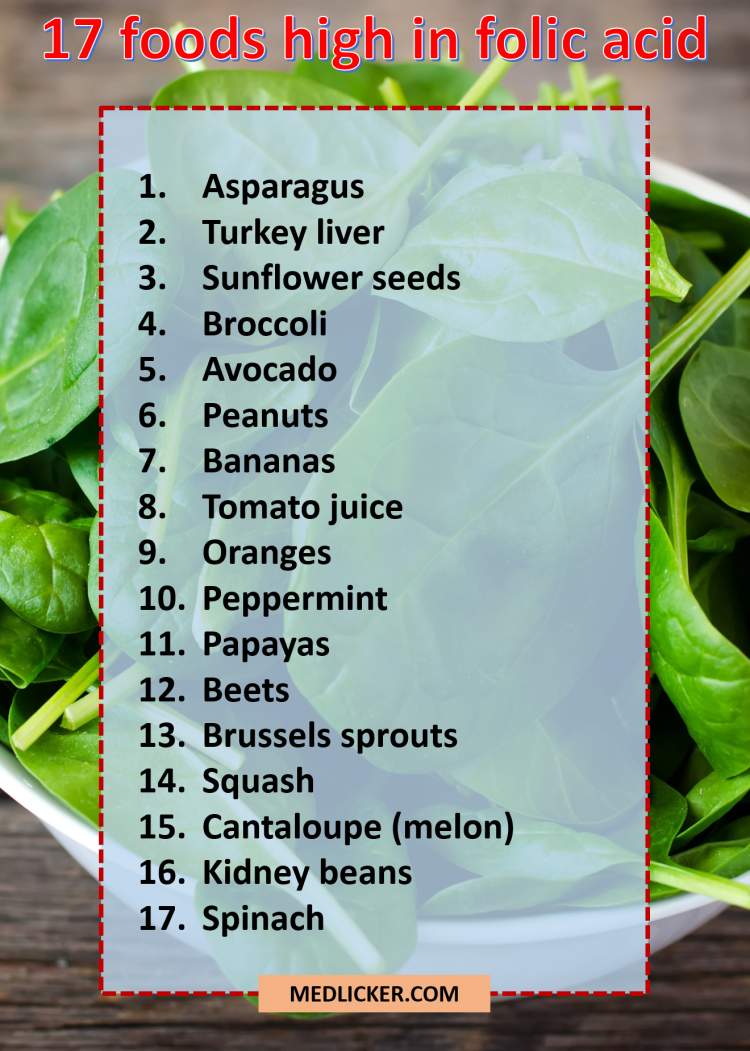
17 foods rich in folic acid
Folic acid is especially important for pregnant females and those who are playing to conceive.
Folic acid deficiency in pregnancy may lead to severe congenital brain and spinal cord issues in the baby, which may be lethal.
Studies have shown that women with low levels of folic acid are at a higher risk of miscarriage.
Therefore females planning to conceive should start taking folic acid before conception and ensure its adequate intake during pregnancy (CDC recommends a daily intake of folic acid of at least 400 mg) https://www.cdc.gov/ncbddd/folicacid/recommendations.html).
Foods naturally high in folic acid include fruits (bananas, oranges, papayas), vegetables (broccoli, squash), peanuts, some meats (turkey and chicken), etc.
Almost all green leafy vegetables contain an abundance of folate.
Nowadays certain big label food companies add folate to their products.
Many kinds of cereal, pasta, biscuits, and flour contain added folic acid.
| Written by: | Michal Vilímovský (EN) |
|---|---|
| Education: | Physician |
| Article resources: | See numbered references in the article. |
| Image resources: | AdobeStock |
| Published: | March 13, 2017 at 11:11 AM |
| Next scheduled update: | March 13, 2019 at 11:11 AM |
Get more articles like this in your inbox
Sign up for our daily mail and get the best evidence based health, nutrition and beauty articles on the web.

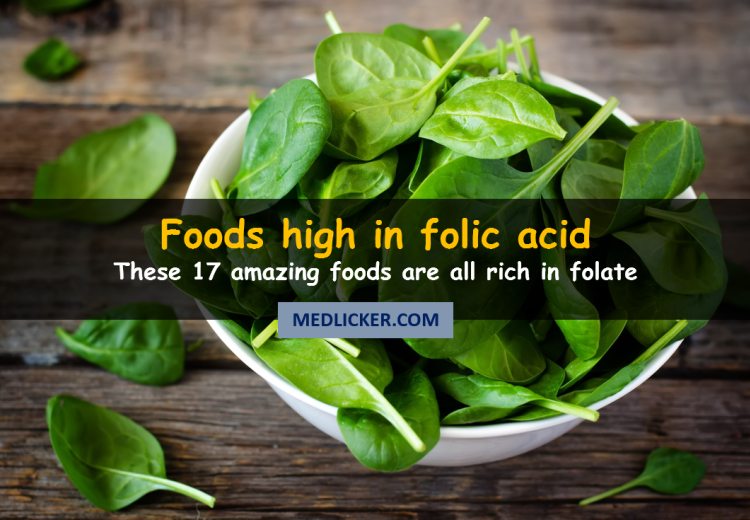
Ache in left arm that you should not ignore
Alkaline water dangers: why you should not drink it
How to Avoid Sleepiness While Studying?
23 Foods That Increase Leptin Sensitivity
Low dopamine (e.g. dopamine deficiency): causes, symptoms, diagnosis and treatment options
Swollen taste buds: the ultimate guide to causes, symptoms and treatment
Thin endometrial lining: causes, symptoms, diagnosis and treatment
Pimples inside nose: the complete guide
Holes in tonsils: definition, symptoms, treatment and prevention
How to deal with an ingrown hair cyst
Allegra vs. Zyrtec vs. Claritin
Allergy to penicillin and alternative antibiotics
How to get rid of phlegm (excessive mucus) in throat? Detailed guide to medical and home remedies, symptoms and causes
What causes stomach ache after meals?
Liver blood test results explained